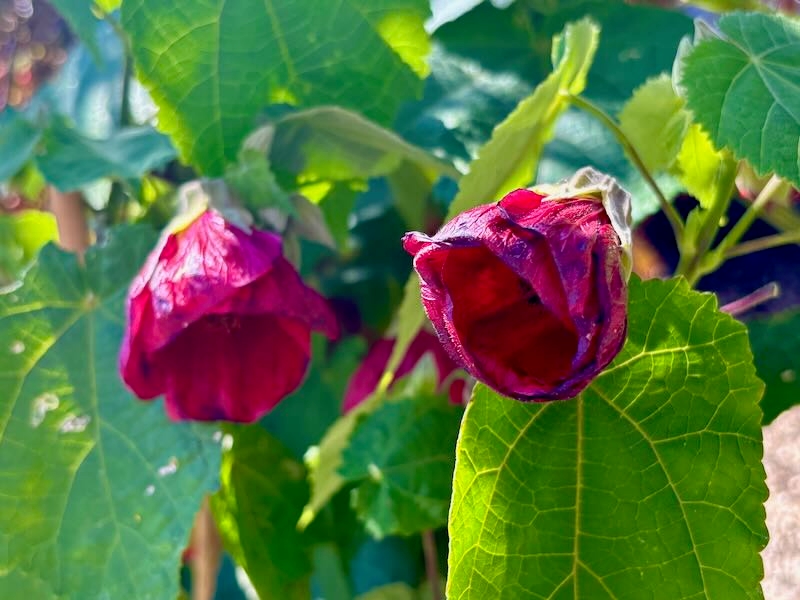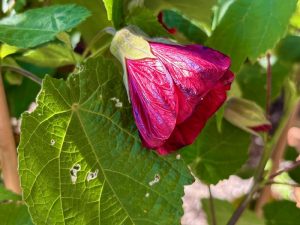Abutilon ‘Nabob’ – A Rich, Maroon-Flowered Beauty for Year-Round Bloom
Abutilon ‘Nabob‘, often known as Nabob Flowering Maple, is a striking evergreen shrub prized for its lush foliage and showy, bell-shaped blooms. A member of the Mallow family (Malvaceae), this hybrid plant delivers a visual punch in the garden with dark maroon flowers that appear intermittently throughout the year, making it a reliable source of color from winter to fall. While called a “flowering maple” due to its lobed leaves that resemble those of a maple tree, it is not a true maple at all.
This plant grows upright with a strong central leader and reaches 2.4 to 3 meters (8 to 10 feet) in height and up to 3 meters (10 feet) in width. However, with regular pruning, you can keep it at a more manageable size. The dark green, lobed leaves are a beautiful backdrop to the three-inch (7.5 cm) wide flowers that hang like lanterns. Each bloom has incurved petals in a rich maroon tone that is nearly black in certain light. These flowers are a magnet for hummingbirds, adding an extra dimension of life to the garden.
Abutilon ‘Nabob’ is a cross between Abutilon darwinii and Abutilon pictum (Abutilon striatum). They occasionally call it by its hybrid name Abutilon x milleri. Despite some taxonomic reclassification into the genus Callianthe, the name Abutilon ‘Nabob’ remains widely used. The Royal Horticultural Society awarded the Award of Garden Merit in 1993 to this plant for its exceptional garden performance.
How to Grow Abutilon ‘Nabob’
Light
Abutilon ‘Nabob’ performs well in a variety of light conditions. Along coastal regions, it thrives in full sun. In hotter inland climates, partial shade is preferable to protect the foliage and flowers from scorching. In shaded settings, the plant still blooms reliably, though full sun exposure encourages more profuse flowering.
Soil
This shrub prefers loamy, well-drained soil. It can adapt to a variety of soil types as long as they do not remain soggy. Soil pH is not a major concern, but neutral to slightly acidic conditions are ideal. Ensure good drainage to prevent root rot and related fungal issues.
Watering
Regular watering is necessary, especially during dry spells or when the plant is grown in full sun. In part shade, the plant becomes moderately drought-tolerant once established. Deep watering is preferable to promote deep root growth, but allow the soil to dry slightly between waterings. Avoid frequent shallow watering, which encourages surface rooting and can weaken the plant.
Fertilizing
A balanced, all-purpose fertilizer applied monthly during the active growing season (spring through fall) will support healthy growth and sustained flowering. If growing in containers, use a slow-release fertilizer or liquid feed every two to four weeks. Reduce feeding in winter when growth slows.
Pruning
Prune in early spring to shape the plant and remove any leggy or damaged growth. Abutilon ‘Nabob’ benefits from annual hard pruning to maintain a compact, attractive shape. Tip pruning throughout the growing season encourages bushier growth and more blooms.
Propagation
Abutilon ‘Nabob’ can be propagated through softwood or semi-hardwood cuttings. Take cuttings in late spring or early summer when the plant is actively growing. Rooting hormone can help improve success rates. The plant is typically not grown from seed, as it is a named cultivar and may not come true to type from seed.
Pests and Diseases Affecting Abutilon ‘Nabob’
Like many members of the Mallow family, Abutilon ‘Nabob’ can be prone to pests, especially whiteflies, aphids, and spider mites. Regular inspections and prompt treatment with insecticidal soap or neem oil can keep infestations in check. Good air circulation and avoiding overhead watering help prevent powdery mildew and other fungal issues. Slugs and snails may occasionally feed on young shoots.
Cold Hardiness and Climate
This plant is hardy to around -4°C (25°F), and it can survive down to -6.7°C (20°F) with some leaf loss. In rare cases, it has been known to survive colder spells, such as the 1990 California freeze when it remained undamaged at -7.7°C (18°F). In areas with potential frost, mulch heavily around the base and consider placing it in a protected microclimate or growing it in a container for easy relocation.
Landscape Uses for Abutilon ‘Nabob’
Due to its continuous bloom cycle, upright growth, and rich flower color, Abutilon ‘Nabob’ serves multiple functions in the landscape. It makes a bold statement as a specimen shrub, especially when paired with other plants that contrast in texture or color. It is also suitable for informal hedges, mixed borders, or as a tall feature in large containers. When kept trimmed, it can work as a backdrop plant for smaller flowering perennials.
The dramatic flowers are particularly effective when planted near patios or windows, where they can be enjoyed up close. The blooms not only add ornamental value but also serve as a vital nectar source for hummingbirds and pollinators throughout the year.
Final Thoughts on Abutilon ‘Nabob’
With its deep maroon blooms, long flowering season, and evergreen foliage, Abutilon ‘Nabob’ is a standout shrub for mild climates. It offers gardeners year-round beauty and dynamic wildlife interest while remaining relatively low-maintenance. Whether you’re looking for a focal point in your landscape or a reliable hummingbird magnet, this flowering maple cultivar deserves a spot in your garden plan.



